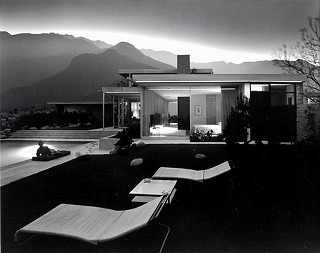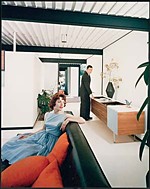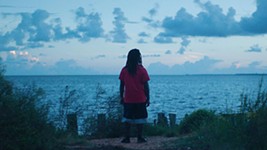What Becomes a Legend Most: The Architect or the Photographer?
AFS Documentary Tour: 'Visual Acoustics: The Modernism of Julius Shulman'
By Anne S. Lewis, Fri., April 3, 2009
Even if his name is not familiar, the architectural photography of Julius Shulman probably accounts, in large part, for how we conjure the midcentury modernist 'geist of Southern California and L.A., in particular. As narrator Dustin Hoffman points out in Eric Bricker's Visual Acoustics: The Modernism of Julius Shulman, "Architects live and die by the images of their work, as these images alone are what most people see." This is certainly the case with Shulman, whose stunning photography, beginning in 1936, of the iconic Southern California houses of Richard Neutra, John Lautner, Rudolph Schindler, Pierre Koenig, and Frank Lloyd Wright are often – to the architects' dismay – credited with the reverence accorded these works.
Think Case Study House #22, Los Angeles, 1960: Shulman's atmospheric image of two young women in white cocktail frocks, sitting in the corner of a flat-roofed, glass-walled house designed by Koenig, perched precariously in the Hollywood Hills atop the twinkling lights of L.A. at dusk, the most reprinted of his photos and viewed as a metaphor for L.A. itself. Or Kaufmann House, Palm Springs, 1947 (the second most reprinted), a glimpse of the Neutra house, shaped like a cross with walls of glass and rock, a sumptuous pool, and a view over the desert to the mountains. Or the photograph of Lautner's Chemosphere House, the eight-sided "flying saucer" house. (Thom Andersen, we'll recall, groused in his Los Angeles Plays Itself film that Hollywood had done these architects wrong, short-changed their work, by forever linking these extraordinary houses to the Bad Guys that inhabited them in the movies.)
In 1999, Eric Bricker, working in L.A. as an art consultant, was tracking down some archival prints when he met Shulman, at that time a spry 89-year-old. Bricker recalls walking into Shulman's studio – "a glass-walled treasure vault filled with photos, books, magazines, and sculptures" – and meeting the man who reminded him of his grandfather and would open a door to a Los Angeles that he did not know existed. The film that Bricker made with the help of a very talented team is a terrific, nuanced exploration of the interplay of craft, aesthetic, history, and personality.
The personality of a still-vibrant, hail-fellow-well-met Shulman, filmed at the age of 98, sets the tone of Visual Acoustics, as he walks (very slowly) and talks us through the decisive moments of his extraordinary career. We learn, from an assortment of talking heads, the context and significance of Shulman's visual style and photographic oeuvre: his understanding of shifting light, his use of perspective, the perfect props and people, and his genius for distilling a building's architectural line. Remarkably, Shulman is still working today; his archive is now housed at the Getty.
Some of the more amusing anecdotes come from the clashes that were absolutely inevitable when two "egocentric" professionals go toe to toe in high-stakes collaborations – the architect who hires the photographer to transmit his work to the world and the photographer with his own ideas of how that should be done, his status resting upon how well and distinctively he does that. Apparently, the Shulman-Neutra show was a classic scrimmage for artistic control. Neutra would typically insist upon dangling a eucalyptus branch right in front of Shulman's lens, to "suggest vegetation," while to Neutra's horror, Shulman would insist upon including the carefully arranged "everyday life" props that he carried around in his car, this being something for which he would become famous. And, of course, the two would take turns moving the camera – when the other wasn't looking.
It's no surprise that the symbiotic relationship between architect and photographer could result in some bitterness. Koenig, who designed the case study house that Shulman made famous, reminded the photographer that architects had to build the buildings before he could photograph them.
Also unsurprising is that the good-natured architectural photographer might not be so patient when the camera was trained on him. Bricker, who now lives in Austin with his family, recalls that "while Shulman was as comfortable in front of the camera as behind it, when in front, he was unable to let go of the hold he had when behind." Which meant some harsh scolding during production. Happily all was forgiven when the subject viewed the finished product. Bricker reports that Shulman has watched the film at least four times and counting.
AFS Documentary Tour presents Visual Acoustics: The Modernism of Julius Shulman on Wednesday, April 8, 7pm, at the Alamo Ritz. Filmmaker Eric Bricker will be in attendance. The screening is also part of the Blanton Museum of Art's "Birth of the Cool" film series. Tickets are $6 for the general public and $4 for AFS members, Blanton Museum of Art members, and students with a valid ID. For more info, see www.austinfilm.org.










